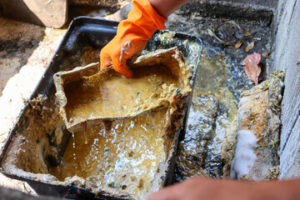Using treats, verbal praise, play, and other positive reinforcements to encourage desirable behavior. In contrast, negative reinforcement (removing something the dog enjoys) discourages unwanted behavior.

Addressing only the symptoms of a problem will always make it worse or create another issue. This is why it’s so important to work with a professional Dog Trainer. Read on Sierra Canine for more information.
Developing self-regulation in your dog contributes to their emotional well-being. It helps them manage their stress levels, allowing them to remain calm and composed even in challenging or exciting situations. This allows dogs to better engage in positive interactions with their human companions and promotes a balanced lifestyle.
It is essential that you create a training environment that is calm and controlled to ensure your dog is receptive to the commands you are trying to teach them. If your dog is too stressed or upset, they are likely to ignore the commands or even react negatively, such as by growling, barking, or pulling on their leash.
When you are unable to maintain control of the training session, take a break and return once your dog has regained their composure. It is also important to have a designated safe space for your dog, such as their crate or a quiet corner of the house, where they can retreat to if they feel overwhelmed.
There are three main training methodologies or “camps” that trainers may fall into. These are:
One of the most common mistakes that people make is attempting to train their dogs using a technique that relies on compulsion or punishment. This type of training is typically referred to as “traditional” or “coercive” training and is the method that celebrity dog trainer Cesar Millan practices, especially in his early TV shows.
The other common mistake that people make is attempting to rush their dog through the training process. Dogs need to learn to be receptive and engaged in their training sessions, which requires time and patience. A dog needs to understand that if they disobey, they will not receive the attention and reward they desire. This is why it is crucial that training sessions are conducted in a controlled and low distraction environment before being moved into more challenging environments.
Establishing Yourself as a Leader
Dog Training helps you improve your relationship with your dog, teaches you how to motivate them through positive reinforcement, and gives you the tools you need to keep your dogs behaviors under control. Whether you have a dog who is constantly digging in the yard, destroying your furniture, or jumping up on friends and family members, it’s important that these behaviors are addressed before they become dangerous or stressful for everyone involved.
Dog training can be focused on improving specific behaviors, but it also teaches you about your dog’s genetic blueprint and how to best work with them. For example, if your dog is bred to dig, training classes can help you find outlets for their natural instincts, like giving them a sandbox in the backyard. This is much safer and more comfortable than yelling at your dog to stop digging.
Lastly, some trainers specialize in specific dog sports and competitions and train their dogs at facilities that are designed for those activities. This type of training is more intense, as the dog will need to be reliable at executing the commands without the use of food or treats.
Many trainers will fall in between these three camps and focus on what’s called LIMA (least intrusive, minimally aversive) training. This is because they have found that using negative reinforcement and punishment actually slows a dog’s progress, as it damages their confidence and relationship with their handler. Plus, dogs who receive too many rebukes will start to limit their range of behaviors, figuring they won’t be successful. This is why it’s so important to find a trainer who will teach you how to reward your dog for the behaviors you want to see, and only use correction when necessary.
Keeping Sessions Short and Manageable
During training, keeping sessions short and fun is vital. As with humans, dogs cannot focus for long periods of time and may lose interest if they are overtaxed. Rather than trying to push through longer training sessions, aim for short (10-20 minute) sessions that are consistent every day. This helps your dog to learn that training is a regular part of their daily routine and can help keep them engaged.
Ideally, you should train in a quiet space free of distractions and make it a point to reward their behavior with treats or verbal praise immediately after they perform the command correctly. This will reinforce the behavior, making them more likely to remember and repeat it in the future. When training, it is also important to avoid yelling or using physical corrections. It is often tempting to correct a misbehavior right away, but it can confuse your dog and lead to them becoming afraid of you.
If you are having trouble getting the results you want from your dog training, it can be helpful to seek out the guidance of a professional. Many dog trainers offer group classes, where you and other dog owners work together on a set curriculum, as well as private training sessions for more specific behaviors like separation anxiety, resource guarding or fearful behaviors.
Dog training is a process that requires patience, and it’s easy to fall into common pitfalls that slow down progress. Inconsistency, rushing into advanced commands before mastering basic ones, and using too much verbal communication are all common mistakes that can hinder your training efforts. By steering clear of these pitfalls, you can see faster results from your dog training and enjoy a stronger bond with your furry friend.
Identifying Common Triggers for Willful Behavior
Dogs can be very influenced by the environment they’re in and what cues are being given to them. This is true for both positive and negative stimuli. When training a dog, the focus and attention of the trainer is essential in keeping the dog calm. Dogs that disobey their owners are often not in the right state of mind to be able to concentrate and respond appropriately to commands. This can be due to an overly stimulating scenario, or simply not having the motivation to do what their owner asks them to do.
Whether the behavior is a simple jump or barking for attention, the key to good training is rewarding the correct behaviors. This can be done with verbal praise, a clicker, or other trained signals. A clicker is preferred by many trainers because it provides a precise, auditory signal that the dog must pay attention to. However, many people choose to use their hands as markers and reward with a treat.
Undesired behaviors must also be punished so that the dog learns not to engage in those actions. Punishment can be physical (pops with a collar, sounds like a clicker or sounding a “no”), or behavioral (removing a desirable reward for disobedience). In order to punish correctly, both adding and removing something must be done in exact combination.
Avoid overly harsh corrections, as this can be a form of punishment and will confuse the dog even more. It is also important to remember that aggression is a last resort for the dog, and if you are correcting them for their natural warning signs such as growling or barking, this can lead to fear and anxiety and even more aggression.
Desensitizing Dogs to Triggers
In desensitization (or counter-conditioning) we want to introduce our dog to their triggers (scary things like noises, people, dogs, environments, and other humans) in doses that are low enough not to elicit any negative emotional responses. We can do this by reconditioning them to the triggers and pairing it with something they love, such as food.
This is a long term process, and it can take weeks to years, depending on the dog, the trigger, and the level of intensity. This is why it’s important to work slowly and carefully – not to push your dog past their threshold and start to do sensitization instead!
For example, let’s say your dog is afraid of fireworks. Find a recording of fireworks and play it at a very low volume, just barely audible. Repeat this for a few days, giving your dog lots of treats each time. Eventually, you will be able to get your dog to the point where they can hear the firework sounds and no longer react negatively.
During this whole process it’s important to keep an eye on your dog and make sure that they don’t begin to exhibit any signs of stress or fear. If they do, you need to back off and go back to the beginning of the training.
Remember, if your dog starts barking or lunging at a trigger, you are doing sensitization instead of desensitization and this is more difficult to reverse.
During this phase, it’s also important to note that you should never distract your dog from their trigger by giving them food before they see the trigger. This can actually reinforce their negative reaction if done incorrectly. To get the most out of CC/DS, always present the food as soon as your dog is showing signs of seeing their trigger!


